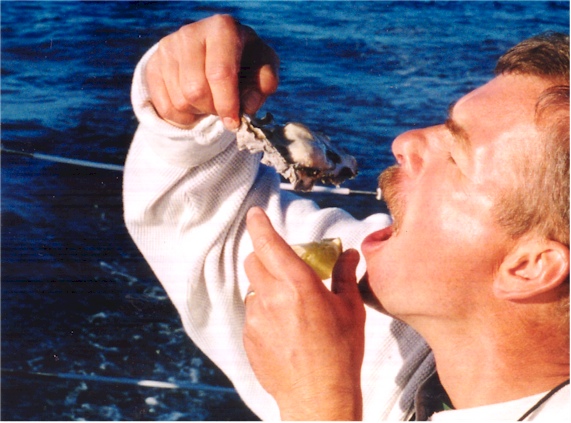Matthew Sigur of the Daily Advertiser reports in a Sunday feature that Louisiana has one of the poorest records in the country when it comes to making restaurant inspections available to consumers.
• Louisiana is one of only nine states that does not make at least some inspections, which are public record, available online. The State Department of Health and Hospitals, which oversees the inspections, first promised a website in 2005 but has so far failed to deliver. Only after weeks of questioning from the Advertiser — and four days before publication of this article — did the DHH announce plans for a site to go live Monday.
• Thirty-nine states allow for some kind of rating with each inspection to make it easier for consumers to know where a restaurant stands relative to others. Louisiana and 10 others do (1)(1).jpg) not. Many other states also insist inspections be posted at the restaurant itself; Louisiana does not.
not. Many other states also insist inspections be posted at the restaurant itself; Louisiana does not.
• Restaurants have little motivation to rush to fix violations. A restaurant cited for violations has at least two months after the initial inspection before a fine can be levied. And not a single restaurant in Lafayette has been shut down by DHH using this process in the past five years.
• Several key stakeholders, including the powerful Louisiana Restaurant Association, openly oppose or sharply question the need for any change that allows the public more access to inspection reports.
• Taken together, these findings paint a troubling picture for consumers, particularly in Lafayette, where great restaurants are one of the city’s top calling cards and eating out is practically a way of life. The issue has taken on added urgency because of a rash of food-borne illnesses making headlines across the country, including an ongoing salmonella outbreak in 26 states that has killed one person and left more than 75 people ill. Closer to home, three patients died and 40 became ill from food poisoning from chicken salad served at Pineville’s Central State Hospital last year. States such as New York, New Jersey and Hawaii have taken recent steps to tighten health regulations in response to growing concerns, but our state has stood pat.
As of now, curious consumers have only one way to view inspection reports for a restaurant. The reports are kept at the local sanitarian services office, open from 8 a.m. to 4:30 p.m. weekdays on 220 W. Willow St. There, you may buy a sanitation report, usually only one or two pages in length, for 25 cents per sheet.
The site, to be called Eat Safe, will feature at-home food safety tips and a restaurant inspections database, Faust said. The site is expected to go live Monday and can be found at www.eatsafe.la.gov. (For this article, the Advertiser requested and received copies of local restaurant inspections since Jan. 1 of this year. A database of the results is available at theadvertiser.com.)
Stan Harris, president of the Louisiana Restaurant Association, believes a website won’t make much difference.
"Where you put the inspections doesn’t make a difference whether people come to your restaurant or not," Harris said. "I’m not certain any online system can make people understand."
"If the public sees this, some of these predefined statements and violations are so vague," local sanitarian Tamika Carron said, "it may not be as bad as it sounds."
(1)(1).jpg) Tenney Sibley, chief of sanitarian services for the DHH, said more information — such as ratings or grades — are unnecessary.
Tenney Sibley, chief of sanitarian services for the DHH, said more information — such as ratings or grades — are unnecessary.
Although Louisiana doesn’t have restaurant ratings now, it wasn’t always that way. In 2005, when the ill-fated website launched, restaurants were graded on a scale of one to five pelicans.
Doug Powell, a Kansas State University professor, said a critical and non-critical system doesn’t give a clear distinction.
"Transparency of information is the only way to build confidence," he said. "The public health folks say, ‘It’s an extra burden.’ The bottom line is getting this information out there so people talk about it. It’s the biggest advantage, and it makes people more aware of food safety."
Without the pressure of transparency and public accessibility, however, business owners may not feel an urgency to address problems.
Filion, K. and Powell, D.A. 2009. The use of restaurant inspection disclosure systems as a means of communicating food safety information. Journal of Foodservice 20: 287-297.
Abstract?
The World Health Organization estimates that up to 30% of individuals in developed countries become ill from food or water each year. Up to 70% of these illnesses are estimated to be linked to food prepared at foodservice establishments. Consumer (1)(2).jpg) confidence in the safety of food prepared in restaurants is fragile, varying significantly from year to year, with many consumers attributing foodborne illness to foodservice. One of the key drivers of restaurant choice is consumer perception of the hygiene of a restaurant. Restaurant hygiene information is something consumers desire, and when available, may use to make dining decisions.
confidence in the safety of food prepared in restaurants is fragile, varying significantly from year to year, with many consumers attributing foodborne illness to foodservice. One of the key drivers of restaurant choice is consumer perception of the hygiene of a restaurant. Restaurant hygiene information is something consumers desire, and when available, may use to make dining decisions.
.jpg) associated with illness. The chicken was cooked approximately 24 hours before serving and not cooled in accordance with hospital guidelines. C. perfringens enterotoxin (CPE) was detected in 20 of 23 stool specimens from ill residents and staff members. Genetic testing of C. perfringens toxins isolated from chicken and stool specimens was carried out to determine which of the two strains responsible for C. perfringens foodborne illness was present. The specimens tested negative for the beta-toxin gene, excluding C. perfringens type C as the etiologic agent and implicating C. perfringens type A. This outbreak underscores the need for strict food preparation guidelines at psychiatric inpatient facilities and the potential risk for adverse outcomes among any patients with impaired intestinal motility caused by medications, disease, and extremes of age when exposed to C. perfringens enterotoxin.
associated with illness. The chicken was cooked approximately 24 hours before serving and not cooled in accordance with hospital guidelines. C. perfringens enterotoxin (CPE) was detected in 20 of 23 stool specimens from ill residents and staff members. Genetic testing of C. perfringens toxins isolated from chicken and stool specimens was carried out to determine which of the two strains responsible for C. perfringens foodborne illness was present. The specimens tested negative for the beta-toxin gene, excluding C. perfringens type C as the etiologic agent and implicating C. perfringens type A. This outbreak underscores the need for strict food preparation guidelines at psychiatric inpatient facilities and the potential risk for adverse outcomes among any patients with impaired intestinal motility caused by medications, disease, and extremes of age when exposed to C. perfringens enterotoxin.
.jpg) I ate most of them.
I ate most of them. that a more complete and robust site was less than three months away.
that a more complete and robust site was less than three months away.(1)(1).jpg) not. Many other states also insist inspections be posted at the restaurant itself; Louisiana does not.
not. Many other states also insist inspections be posted at the restaurant itself; Louisiana does not.(1)(1).jpg) Tenney Sibley, chief of sanitarian services for the DHH, said more information — such as ratings or grades — are unnecessary.
Tenney Sibley, chief of sanitarian services for the DHH, said more information — such as ratings or grades — are unnecessary.(1)(2).jpg) confidence in the safety of food prepared in restaurants is fragile, varying significantly from year to year, with many consumers attributing foodborne illness to foodservice. One of the key drivers of restaurant choice is consumer perception of the hygiene of a restaurant. Restaurant hygiene information is something consumers desire, and when available, may use to make dining decisions.
confidence in the safety of food prepared in restaurants is fragile, varying significantly from year to year, with many consumers attributing foodborne illness to foodservice. One of the key drivers of restaurant choice is consumer perception of the hygiene of a restaurant. Restaurant hygiene information is something consumers desire, and when available, may use to make dining decisions..jpg) food safety agencies here and there,
food safety agencies here and there,  Health and Food Safety announced.
Health and Food Safety announced. and associate administrator at Central Louisiana State Hospital have, as they politely say in the South (and smile while the knife goes in), left the facility.
and associate administrator at Central Louisiana State Hospital have, as they politely say in the South (and smile while the knife goes in), left the facility. Louisiana state officials say
Louisiana state officials say in Mississippi – at a seafood conference, repeat, at a seafood conference — became sick after eating oysters believed to be traced to that area.
in Mississippi – at a seafood conference, repeat, at a seafood conference — became sick after eating oysters believed to be traced to that area.